Blog posts are the backbone of digital marketing, with endless utility. And it’s taking longer and longer to write them, as Orbit Media’s annual survey notes.
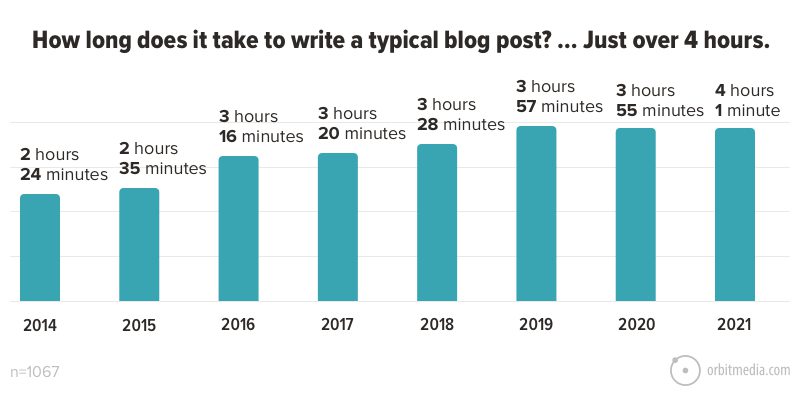
Let’s review the many types of blog posts and how they may align with your marketing goals.
- Listicle.
- Interviews.
- How-To.
- Roundup.
- Predictive.
- Retrospective.
- Personal.
- Guest Post.
- Guide.
- Comparison.
- Proprietary Research.
- Visual.
- Thought Leadership.
1. Listicle
The listicle is as its name implies: a list article that can be just a few points or hundreds.
In our day, there has been an enormous number of “mega” listicles that go above and beyond the closest competition on the web. We’ve even published a few ourselves. See: 99 Benefits of Content Marketing (and You Need Each One).
There’s a considerable amount of one-upmanship happening in the listicle space as well. Two of the most common examples of this are stat- or tip-based lists.
Stats
A list post loaded with data points generates traffic because data is in high demand in virtually every industry. A search of “marketing stats 2021” yields headline promises of 110 or even 137 stats.
Clearly, the game here is to produce the most exhaustive compilation of data points possible on this particular topic.
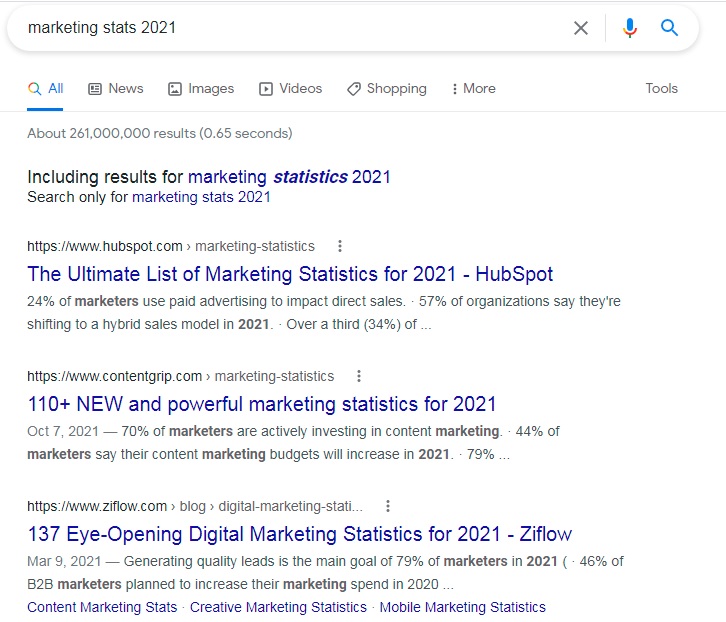
Another key insight here is the use of bombastic language like:
- Ultimate.
- Powerful.
- Eye-opening.
There’s certainly a level of clickbait involved in these titles. And you’ll also notice the use of the current year.
So, overall, one assumption you can make is that adjectives + long lists + years in headlines = stronger rankings. That doesn’t factor in links, quality or various other ranking factors, of course, but it’s a takeaway nonetheless.
Your specific topic should be well-written first, then the headline can be optimized second.
Tips
The same premise applies to tip-based listicles. Below we see 52, 10, 24 and 17 potential tips on display.
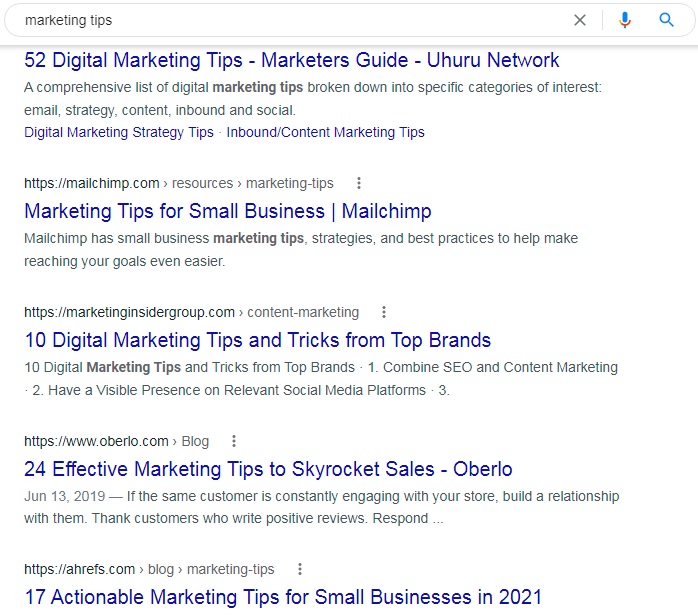
Listicles are an essential and effective way to create dense content that empowers readers to stay on one individual page (your listicle!) rather than pogo-sticking back to the search engine results page (SERP) to find more tips elsewhere.
During the research process — for a new product, for background knowledge, etc. — the ability to find everything you need in one list is simply time well-spent — for the reader and the blogger.
One final note on listicles is that they’re predominantly evergreen, and this is key. An evergreen post is designed to be a mainstay on the internet, useful to readers of today and far in the future. As a digital marketer, all you need to do is ensure your lists remain updated and relevant as time goes on.
That might simply entail swapping out a few tips or stats once a year, or the reoptimization process could require rewriting chunks of the post — whatever it takes to bring value to a modern reader. In any case, both paths are cheaper and faster than creating brand new blog posts from scratch.
Subscribe to
The Content Marketer
Get weekly insights, advice and opinions about all things digital marketing.
Thank you for subscribing to The Content Marketer!
2. Interviews
Interview-based content is another go-to option for marketers looking to expand the types of blog post formats they publish.
What hard data offers you in quantitative credence, interviews supply in qualitative insights that can turn a generic blog post into something more tangible and credible.
Articles built on interviews can provide:
- Subject matter expertise.
- Relevant quotes and reporting.
- An element of humanity and subjectivity.
- Citations from reputable industry leaders and publications.
Interviews don’t have to be one-on-one phone calls or Zoom meetings, either. You can easily transcribe podcasts and webinars to tease out suitable quotes, use cases and testimonials.
To get the most out of your interviews, consider creating a blog series that can continue indefinitely with each new expert you talk to.
3. How-To
How-to articles are incredibly purposeful because they’re more than tutorials or instructionals. They’re great opportunities to answer a lot of user questions and search queries in a succinct article.
“How”-based questions give you as a marketer key insight into search intent, thus allowing you to properly structure and style your blog post to the exact specs of your audience. They want to know how to do something, not necessarily what to do or why to do it. This is a distinction that can easily be missed.
The “how” article is a foundational concept in organic marketing, leading to an entire industry of publications devoted purely to it. Think eHow and wikiHow, as well as popular corners of YouTube, Quora and Reddit.
Google’s “People also ask” and “Related searches” features further speak to the necessity of understanding user questions and answering them appropriately in your content.
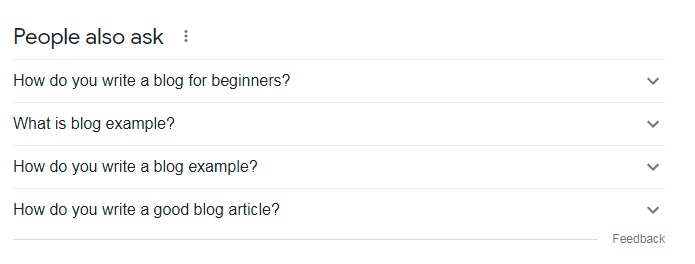
You can use free tools like AnswerThePublic or even the Google SERP to see all the “how” queries you could be targeting in your content. Or, paid tools like MarketMuse, SEMrush or Ahrefs host features like “questions to answer” or keyword-matching “questions.”
4. Roundup
To stay on top of industry trends and current events, a roundup post is an easy way to check a lot of boxes. By devoting a paragraph or two to several different subjects, you can quickly summarize for your reader what they otherwise would have to gather from multiple sources.
Roundup articles are great for:
- Post-event takeaways.
- Conference insights.
- Newsworthy industry announcements.
- Curated resources.
Readers short on time can skim your article and get practical information for little tradeoff, which is a nice contrast to long-form content that requires lots of reader concentration and attention.
5. Predictive
Prediction posts usually pop up near the end or the start of a year. This is the time when people want to hear about future trends in the hopes they can be ahead of the curve in some way.
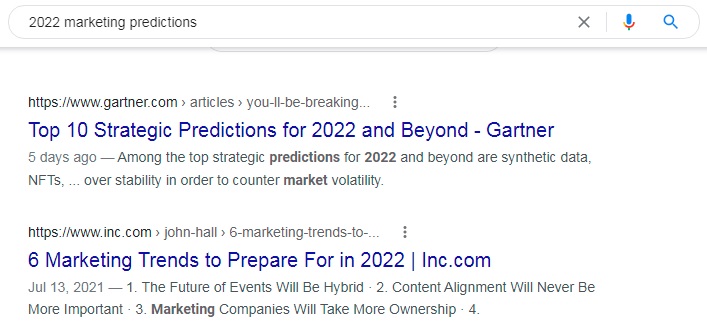
Some of the world’s top brands and publications — like Gartner and Inc. — routinely post predictive blogs on lots of topics as a mechanism to drive more clicks and links.
This strategy can work for both B2C and B2B. With optimized titles featuring numbers, dates and future promises, these types of blog posts can also work well on social media or even as part of website roundups.
6. Retrospective
The opposite of the prediction article is the retrospective. Looking back on the past quarter or year is a way to:
- Show humility in some of your wrong assumptions.
- Explore past data and trends from a new vantage point.
- Provide words of wisdom or learning experiences.
- Offer historical reasoning for certain company decisions.
Retrospective posts tend to be a bit more personal and reflective, like this post from Brafton’s Adam Barber: My Digital Marketing Predictions That Never Happened (and the Problem With All Prediction Posts).
By posting a variety of blog types — including forward- and backward-looking ones — you can show readers a fuller and more transparent view of your opinions.
7. Personal
Newspapers, tabloids and lifestyle blogs are full of first-person narratives and think pieces — B2B blogs not so much.
That doesn’t mean there isn’t a space for personal stories, observations or venting on a company blog, as long as they’re in good taste and still fit larger brand guidelines.
Rant
Take, for instance, a personal (but professional) rant. We populate our blog with a few rants from time to time, such as:
- How Salespeople Have Turned LinkedIn Into a Hellhole (and How to Do Better).
- Rant: The Trouble With SEO Agencies.
This format often entails a punchier, more voicey tone. Of course, the topics themselves are still relevant to our audience and industry, which is key.
Storytelling
A strong narrative that takes readers by the hand can be super impactful as well. Customer success stories and walkthroughs exemplify the value of a good story — even better if backed by data:
- A Positively Easy Technique for Measuring Content Marketing [Success Story]
- How We Reduced a Client’s Cost-Per-Lead 63% Through Balanced Content Marketing [Success Story].
Company Announcement
In this case, a company announcement is personal to your brand. It might not offer much in the way of search rankings, but informing and educating your audience on your business’s latest happenings is important for brand (and product) awareness.
Just launched the next generation of your software? Received a vital new round of funding? Working on tackling big problems?
Let the world know. And don’t feel slimy about tooting your own horn.
Company announcements are often read by job applicants, vendors and business partners, making these types of posts intrinsically valuable for recruitment and brand messaging.
8. Guest Post
Guest posts are bidirectional: You can create or solicit an unlimited number of blogs to be posted on your site or others’.
This means you can derive twice the value from your efforts. While you’re writing articles to be published on relevant industry websites, you can simultaneously accept guest contributions for your own blog page.
Most sites have contribution guidelines easily found in their bottom nav, or you can just send a friendly inquiry over email. For the most part, you should only be posting on sites that:
- Overlap with elements of your existing audience.
- Are reputable from brand recognition and Domain Authority perspectives.
- Offer follow links back to a page of your choosing.
- Have some sort of framework for promoting your work or managing commentary.
The most tangible upside of guest blogging is securing backlinks. Because links are a top three Google ranking factor, building links back to your site is one of the most critical initiatives you as a marketer and SEO can undertake.
One final note on guest posts: Contributing to other publications can boost your overall brand reach, allowing you to find and establish new followings that may at some point down the road yield direct business value.
9. Guide
Though the length of marketing blog posts has risen since their inception, there isn’t a hard rule for word count. As HubSpot research finds, blog posts can serve different goals, which should warrant varying word counts — for an SEO-specific blog, that often ranges between 2,100 to 2,400 words.
Of course, your target keyword and topic will factor into this variance.
That said, long-form guides are certainly a staple of modern content marketing. Long-form content correlates to:
- More comprehensive and informative content.
- Greater breadth and depth of keywords, phrases and subtopics.
- Increased likelihood of rankability.
Correlation does not imply causation, but it’s true that greater lengths allow more opportunities to include high-value keywords and answer search queries. That’s what makes guides so valuable.
Among other formats, guides might include:
- In-depth industry research.
- Tutorials or explainers.
- Listicles or how-tos.
The underlying theme of a guide is a deep dive into a given topic, making it more expansive and exhaustive than average blog posts. In some cases, you might actually choose to gate content of this kind, add lots of visuals or use it as the cornerstone of your marketing strategy.
Brian Dean, founder of Backlinko, is the king of guides, making them the centerpiece of his website, social media and email campaigns. These posts can run upward of 3,000 words easily.
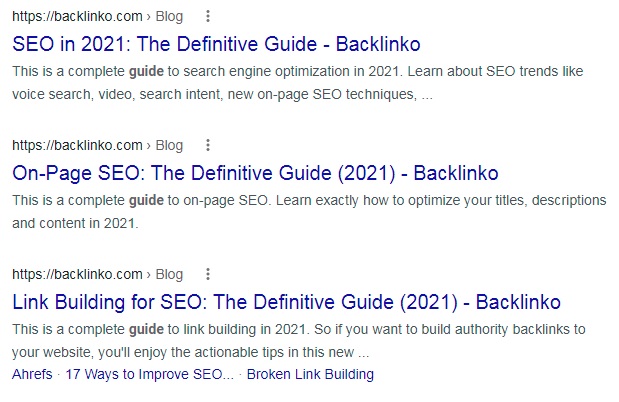
10. Comparison
Entire industries are rooted in product or service comparisons.
There’s G2 and Capterra for side-by-side software reviews. In the hardware space, there’s PCMag and CNET. These businesses function to provide users with the comparisons they need to make decisions.
They’re now so important that product information and user reviews on business directories are top ranking signals in search engines.
On your blog, you can provide readers with firsthand experience using certain tools or strategies — or whatever might be useful to your audience.
We’ve experimented with this approach by writing about use cases for marketing technologies:
- SEMrush Keyword Magic Tool: How to Develop an Enchanted Content Strategy (Tutorial).
- Does Clearscope Work as an SEO Content Writing Tool?.
- Ranking the 6 Most Accurate Keyword Difficulty Tools.
By comparing and contrasting different concepts or services, you can offer your audience unbiased insights a bit further down the funnel.
11. Proprietary Research
One of the most time-intensive and technical varieties of blogging is proprietary research.
Publishing unique data or findings accomplishes several marketing tasks:
- It brings something of value to the marketplace.
- It offers a different or distinctive idea.
- It builds on or adds to existing themes or commentary.
- It increases SEO through Google’s E-A-T guidelines.
Proprietary research can take many shapes, including:
- Private data from your company or clients that you make public.
- Analytics or trends derived from technical research.
- Survey or poll results.
- Findings from experiments.
These data points can be converted into a blog post and further leveraged for linkbuilding efforts. As the sole owner and publisher of unique research, your page likewise be the sole link available on the web for sites that cite your post.
As these links accrue, your page sends strong ranking signals to Google indicating your content is the go-to resource on this specific topic.
12. Visual
All of the above blog formats can be a combination of written, graphical or video content. Though blog posts are primarily text-based, more marketers are focusing on additional visual embeds within their content.
Visual blogs might include:
- Charts and graphs.
- Interactive maps or tools.
- Scroll- or click-triggered widgets, pop-ups or animations.
- Social media or video embeds.
- Photography.
- Custom illustrations or infographics.
- GIFs.
- Slideshows.
One point of warning: The more imagery that’s added to pages, the greater the need for optimization. Google’s Core Web Vitals guidelines measure the loading times of on-page elements. But not all websites have compressed their images, used proper meta tags or removed unnecessary code.
As a result, visual-heavy blogs might unexpectedly impede search crawlers. So, be sure to explore your Core Web Vitals report within Search Console and make any changes accordingly.
For ideas to get you started on visual content, check out this blog on some of top visuals in 2021.
13. Thought Leadership
Everything you publish online could technically be viewed as thought leadership. In the truer sense of the term, though, we’re referring to distinct content that is focused less on SEO and more on showcasing your expertise.
Thought leadership blog examples may include:
- Promoting upcoming events or webinars you’re hosting or speaking at.
- Contributing to podcasts or Q&As — then transcribing responses.
- Making strong claims about the industry based on your experience.
- Providing in-depth, thoughtful teardowns of important concepts or techniques.
All in all, this blog post type is designed to generate social media shares and lively commentary on topics that are highly relevant to current or future trends.
The above blog formats come in a variety of shapes and sizes, and there’s a lot of crossover between them. Don’t put yourself in a box, believing you must adhere to certain style constraints.
Instead, create content that adds demonstrable business value through clicks, shares, rankings, leads and goal completions. What else could you ask for from a blog?





